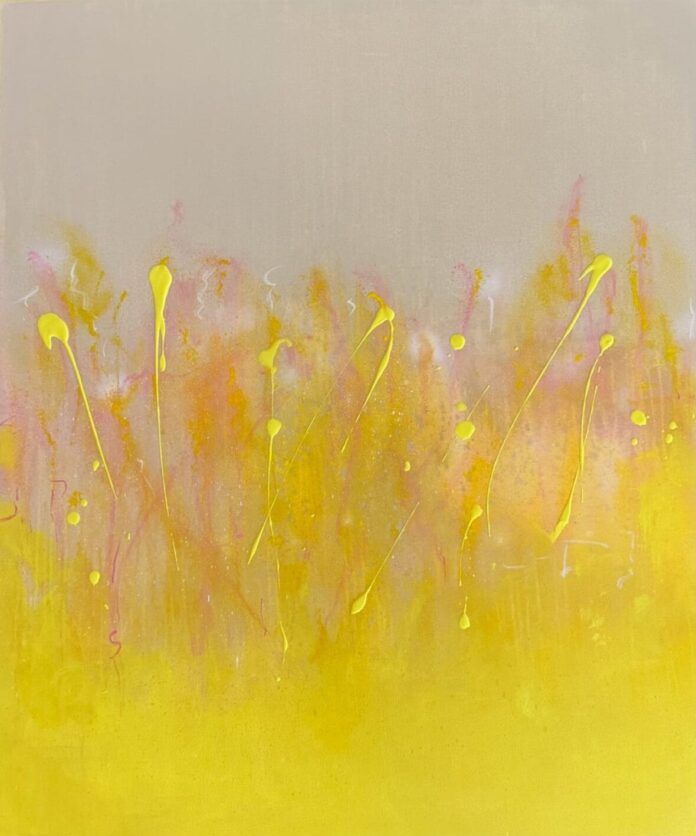Karolin Brünink is a contemporary artist whose work explores the depth of human emotion through dynamic expressionism. Her paintings are not constructed from rigid plans or controlled compositions, but rather emerge through instinct, rhythm, and the natural flow of inner movement. For Brünink, creating art is not about reaching a final image. It is about discovering what wants to appear when control is released and emotion takes the lead.
Brünink’s creative process is deeply intuitive. Each piece is a spontaneous unfolding guided by energy and feeling, not logic or structure. As she moves across the canvas, her brush follows internal rhythm, emotional impulse, and moments of presence. She doesn’t aim to depict something specific. Instead, she allows the painting to evolve, to breathe, and to find its own voice. The result is artwork that invites the viewer to connect emotionally rather than analyze intellectually.
A Response to a Fast-Paced World
In today’s high-speed digital age, Brünink’s art serves as a quiet yet powerful counterbalance. Her paintings are not distractions or quick visuals. They are invitations to slow down, feel, and remember. They reflect a desire for authenticity and emotional resonance in a world that often rewards efficiency over depth.
Brünink’s work is rooted in values like self-determination, personal truth, and healing through creativity. Her art does not tell the viewer what to see or how to feel. Instead, it opens space for each person to engage on their own terms, to bring their own emotions into dialogue with the work.
A Practice of Letting Go
At the heart of Brünink’s philosophy is the belief that true art comes from letting go. She trusts her instincts. She listens to her body. She allows the energy of the moment to guide her. This openness creates artwork that feels alive, filled with motion, layers, and emotional nuance.
For Brünink, painting is not simply a technique or career. It is a process of transformation. It is a healing ritual, a form of reflection, and a way of reconnecting with what matters most. Her practice is about being present, tuning in, and allowing creativity to surface without judgment.
Lightscapes: A Painting of Atmosphere and Emotion
Brünink’s recent work, titled Lightscapes, captures the essence of her artistic vision. Created using acrylic on canvas, this piece is a vivid yet delicate abstract composition that evokes the feeling of a radiant, dreamlike landscape. It doesn’t depict a literal place but offers a sense of light, space, and quiet joy.
The bottom of the painting glows with an intense sunlit yellow, creating a warm and grounded foundation. As the color rises, it gently fades into a soft, mist-like grey-beige near the top of the canvas. This transition evokes the subtle shift of morning light or the stillness of an early haze.
In the central portion, a band of fine lines and gentle splashes of rose, orange, and yellow tones adds movement and texture. These marks suggest the presence of grasses or delicate flower stems swaying in the breeze. The imagery is not direct but impressionistic, creating a feeling rather than a form.
Lightscapes invites the viewer into an imagined world where atmosphere, not narrative, is the focus. It offers a sense of openness, warmth, and uplift. It is not about what the viewer sees but about what they feel while looking. The piece speaks through light, color, and energy, allowing space for quiet connection.
Abstraction as Inner Mirror
Brünink’s commitment to abstraction is not an aesthetic choice alone. It reflects her deeper belief that emotion, sensation, and memory often live beyond words or clear images. Her use of color and movement mirrors internal states the quiet shifts of mood, the waves of feeling, and the inner changes that shape our experience.
Rather than illustrating ideas, she paints moments of resonance. Her work allows viewers to engage with their own inner landscapes, to reflect on memories or sensations that might otherwise go unnoticed.
In this way, Brünink’s art becomes a mirror. Not a mirror of the outside world, but of the inner world, a reflection of what it means to feel deeply, to pause, to reconnect.
The Role of the Viewer
Brünink does not position herself as a storyteller or instructor. She does not provide explanations or dictate meaning. Instead, she sees the viewer as an equal participant in the creative process. Her paintings are not complete until someone stands before them, brings their own life experience, and begins to feel something stir.
Whether a viewer finds calm, clarity, nostalgia, or inspiration, the meaning of the work is always evolving. It depends not just on the artist’s intention, but on the viewer’s openness to engage.
This sense of mutual discovery gives Brünink’s work a timeless quality. It transcends trends or surface appeal. It offers depth, honesty, and a return to emotional truth.
A Quiet Power
What makes Karolin Brünink’s work so compelling is its quiet power. Her paintings do not demand attention. They do not shout. They resonate. They invite. They offer space to breathe and space to feel.
In every brushstroke, there is presence. In every layer of color, there is intention. And in every finished piece, there is a reminder that beauty can emerge not through control, but through trust in the process, in emotion, and in the unknown.
Brünink reminds us that true art does not come from perfection. It comes from vulnerability. From presence. From letting go.
True art is born not from control but from allowing something deeper to surface.


